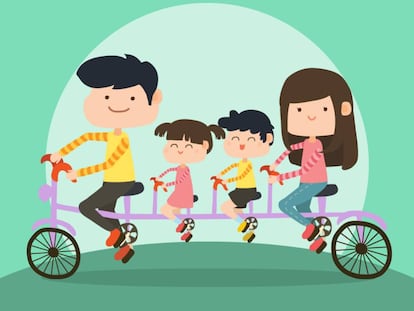Five ways to say “no” without hurting someone’s feelings
Setting limits is one of the hardest tests we face — and one of the best ways to measure our maturity

You’ve probably had this conversation with your friend, family member, or boss – the one where they ask you to do them a favor that you really don’t want to do, but you agree to do anyway. It’s not because the other person has a remarkable ability to manipulate you, but simply because it would have been harder for you to say no. Setting limits is one of the hardest tests we face – and one of the best measures of maturity (and of mental health, of course). Admit it, it’s not easy. Our own fears don’t help much either. As Aristotle said, we are social animals, which means we give our heart and soul to belong to a group. That is why we try so hard to please, love to see we are needed and suffer so much when we have to say “no” to the people we care about. Luckily, we become more comfortable with this over the years.
As we grow older, we feel less scared to say no
When we are teenagers, we cling to our group and generally care more about what our peers think than what our teachers or our poor parents have to say (which is why adolescence is also one of the hardest stages for a parent). However, as we grow older, we start to define our own personality and character, and feel stronger and less vulnerable when we say “no.”
Gender also plays a role. According to several studies, women tend to be more eager to please than men because of social (or historical) pressure, which is why female assertiveness is frowned upon. But that being said, we still need to learn how to say no. It is the best way to protect our boundaries, practice self-care, and grow as people – without the need for constant validation from others. Learning how to say no doesn’t automatically make you unpleasant or harsh. It can be done in a diplomatic way, without causing offense, while standing tall and avoiding conflict. Let’s learn how to say no to the people it’s hardest to say no to: those we care about.
1. Identify the boundaries you want to set and with whom. First you have to ask yourself who is it you give in to most: is it your significant other? Your boss? Your co-workers or friends? How do they get you to buckle: through aggression or flattery? Or do they not have to do anything at all? These questions will give you clues. Once you’ve figured this out, you can set a concrete goal and use the following steps to implement it.
2. Give your answer in a friendly way, according to your goals and without too much explanation: “I can’t help you write that report, because my boss wants this other one on his desk tomorrow morning and I’m running out of time.” Don’t list infinite excuses that bore the other person and weaken you; or use excuses that can easily be countered. If you say: “I can’t go to your party because I won’t have any time to cook myself dinner,” the other person could say that they’ll provide dinner for you, or that you can stop by the store below their apartment and get a quick bite to eat… Their response invalidates your excuse.
Saying no is the best way to protect our boundaries
3. Negotiate. In the case of the previous example, you can tell your friend that you won’t be making it to the party for whatever reason, but that you still want to see them and suggest a plan for another day. Or in the case of your co-worker who asks you to write a report, you can tell them that you can’t at the moment, but you can help after you finish the current report you are writing. This way you leave a window of opportunity open.
4. Explain the impact to other people. You could say something like: “If I help you, I’ll have to say no to so and so.” This gives you a stronger standing and an argument to back you up. You see this used a lot with family events, for example: “I can’t make the meeting today because I promised my son I’d go to his school event.”
5. Learn from someone who handles these situations well and experiment with your own methods. One of the advantages of social beings is that we can improve by observing others. Focus on someone whose skills you admire, analyze their arguments and body language, and practice their strategies – first in easy situations, then in harder ones.
In the end, learning to say “no” is essential to saying “yes” to what we truly care about. We need do this to if we are take care of ourselves, protect others and the projects we do want to do, and ensure we don't disappoint by biting off more than we can chew.
English version by Laura Rodríguez.
Tu suscripción se está usando en otro dispositivo
¿Quieres añadir otro usuario a tu suscripción?
Si continúas leyendo en este dispositivo, no se podrá leer en el otro.
FlechaTu suscripción se está usando en otro dispositivo y solo puedes acceder a EL PAÍS desde un dispositivo a la vez.
Si quieres compartir tu cuenta, cambia tu suscripción a la modalidad Premium, así podrás añadir otro usuario. Cada uno accederá con su propia cuenta de email, lo que os permitirá personalizar vuestra experiencia en EL PAÍS.
¿Tienes una suscripción de empresa? Accede aquí para contratar más cuentas.
En el caso de no saber quién está usando tu cuenta, te recomendamos cambiar tu contraseña aquí.
Si decides continuar compartiendo tu cuenta, este mensaje se mostrará en tu dispositivo y en el de la otra persona que está usando tu cuenta de forma indefinida, afectando a tu experiencia de lectura. Puedes consultar aquí los términos y condiciones de la suscripción digital.
More information
Archived In
Últimas noticias
There is as much life left to discover on planet Earth as that which is already known
Dozens presumed dead, around 100 injured in fire at Swiss Alps bar during New Year’s celebration
Is porn for women different from conventional porn? We spoke to those who make it
Cartagena de Indias is sinking: What can the city do to mitigate it?
Most viewed
- David King, chemist: ‘There are scientists studying how to cool the planet; nobody should stop these experiments from happening’
- Reinhard Genzel, Nobel laureate in physics: ‘One-minute videos will never give you the truth’
- Oona Chaplin: ‘I told James Cameron that I was living in a treehouse and starting a permaculture project with a friend’
- Sinaloa Cartel war is taking its toll on Los Chapitos
- The Interoceanic Train, the Mexican alternative to the Panama Canal










































